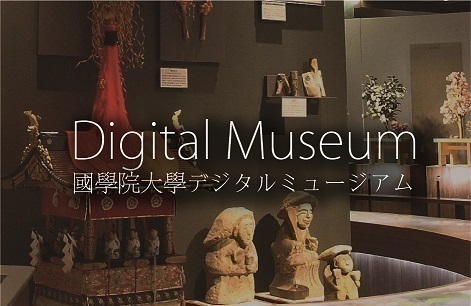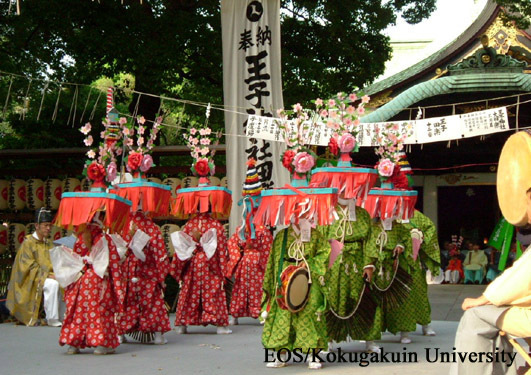- トップ
- Encyclopedia of Shinto
- Sarugaku, Dengaku
Encyclopedia of Shinto
| Main Menu: | |
| Links: |
詳細表示 (Complete Article)
| カテゴリー1: | 5. Rites and Festivals |
|---|---|
| カテゴリー2: | Performing Arts |
| Title | Sarugaku, Dengaku |
| Text | Sarugaku was the term used for the performing art of nō until the Edo period (1600-1867). It is also used to refer to the older sarugaku before its development into the classic nō. The origin of sarugaku can be traced back to the sangaku imported from China during the Nara period (710-784). The pronunciation of sangaku began to shift from the mid-Heian period (784-1192), and the characters for sarugaku (猿楽, lit. "monkey music" or "monkey entertainment") gradually came to be used. Training in sangaku took place at designated households known as sangakko until they were abolished in 782. During the Heian period, performances were given by members of the imperial guard or court musicians as entertainments at sumō or kagura events, or by itinerant sangaku performers at shrine or temple festivals. In addition to acrobatics and stunt performances introduced from China, the sangaku arts also grew to include feats of humorous mimicry. The mid-eleventh century Shin-sarugaku-ki (Record of the New Sarugaku) by Fujiwara no Akihira records a variety of new sarugaku arts that had become popular with the common people as performed in local festivals. From the Kamakura period (1192-1333) to the so-called period of the Northern and Southern Courts (1333-1392), sarugaku underwent significant developments. For one thing, the ritual performance of the old man figure Okina came to be emphasized as the accomplishment that symbolized the essence of sarugaku. At the same time, the pre-existing element of improvisational mimicry took on more dramatic form and musical and dance elements were also added. Many sarugaku troupes appeared, mainly in the Kinki region of western Japan. Among these was the Kanzei troupe of the Yamato (Nara) area, led by the father and son team of Kan'ami and Zeami, who are well known as the pair who perfected the form of classic sarugaku nō. Dengaku can be broadly divided into two types: the tabayashi type for providing musical accompaniment to rice planting that originated in cultivation rituals; and the dengaku odori (dengaku dance) performed by dengakuhōshi (dengaku masters) who created a new art form related to sangaku. The sasara (a wooden percussive clapper) is the instrument that distinguishes dengaku, and the instrument's form is different for each type of dengaku. Performers use the surizasara (two serrated sticks rubbed together) in the tabayashi, while the binzasara (a shaker made up of wood chips threaded together on a string) is used for dengaku odori. The Eiga monogatari (A Tale of Flowering Fortunes) contains a detailed description of a tabayashi-style dengaku seen by Fujiwara no Shōshi, a figure in the epic work, in the fifth month of 1023. Colorful and lively dengaku of this sort presented for aristocrats to view were presented frequently until the end of the Heian period. Their vestiges can be seen in the dengaku known as hanadaue and hayashida that in modern times are performed to accompany rice-planting in Hiroshima and Shimane prefectures. Professional dengaku performers already existed in the mid-Heian period, but for the tabayashidengaku of 1129 they were joined by a new type of performer known as the dengaku hōshi. The appearance of the dengaku hōshi, who in addition to the dengaku odori also performed sangaku acrobatics, would stimulate the subsequent development of dengaku. They established ties with shrine festivals, formed two guilds (za)—the "original guild" (honza) and the "new guild" (shinza)—and evolved into one of the chief performing arts of the medieval period. A new variety of dengaku known as dengaku no nō was added to their repertoire in the process. Note also that in the summer 1096 a legion of dengaku troupes paraded through the streets of Kyoto and caused a great disturbance. The dengaku of this particular age is known as Eichō ōdengaku (great dengaku of the Eichō era [1096-1097]). However, more broadly dengaku of this sort, including dengaku odori, that were performed in imitation of tabayashi-style dengaku but without the actual rice planting are referred to as furyū dengaku. Dengaku once had a popularity that exceeded that of sarugaku, but in the mid-Muromachi period dengaku was eclipsed by the development of sarugaku and went into decline. Today it only just survives as a folk performing art. — Takayama Shigeru |





